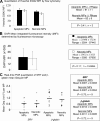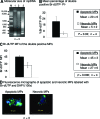Membrane protected apoptotic trophoblast microparticles contain nucleic acids: relevance to preeclampsia
- PMID: 18974299
- PMCID: PMC2626372
- DOI: 10.2353/ajpath.2008.080414
Membrane protected apoptotic trophoblast microparticles contain nucleic acids: relevance to preeclampsia
Abstract
Microparticles (MPs) that circulate in blood may be a source of DNA for molecular analyses, including prenatal genetic diagnoses. Because MPs are heterogeneous in nature, however, further characterization is important before use in clinical settings. One key question is whether DNA is either bound to aggregates of blood proteins and lipid micelles or intrinsically associated with MPs from dying cells. To test the latter hypothesis, we asked whether MPs derived in vitro from dying cells were similar to those in maternal plasma. JEG-3 cells model extravillous trophoblasts, which predominate during the first trimester of pregnancy when prenatal diagnosis is most relevant. MPs were derived from apoptosis and increased over 48 hours. Compared with necrotic MPs, DNA in apoptotic MPs was more fragmented and resistant to plasma DNases. Membrane-specific dyes indicated that apoptotic MPs had more membranous material, which protects nucleic acids, including RNA. Flow cytometry showed that MPs derived from dying cells displayed light scatter and DNA staining similar to MPs found in maternal plasma. Quantification of maternal MPs using characteristics defined by MPs generated in vitro revealed a significant increase of DNA(+) MPs in the plasma of women with preeclampsia compared with plasma from women with normal pregnancies. Apoptotic MPs are therefore a likely source of stable DNA that could be enriched for both early genetic diagnosis and monitoring of pathological pregnancies.
Figures









Similar articles
-
Placental release of distinct DNA-associated micro-particles into maternal circulation: reflective of gestation time and preeclampsia.Placenta. 2009 Oct;30(10):891-7. doi: 10.1016/j.placenta.2009.06.012. Epub 2009 Aug 18. Placenta. 2009. PMID: 19692120 Free PMC article.
-
Microparticles and pregnancy complications.Thromb Res. 2011 Feb;127 Suppl 3:S67-71. doi: 10.1016/S0049-3848(11)70019-6. Thromb Res. 2011. PMID: 21262446
-
Hypoxia-induced membrane-bound apoptotic DNA particles: potential mechanism of fetal DNA in maternal plasma.Ann N Y Acad Sci. 2006 Sep;1075:57-62. doi: 10.1196/annals.1368.007. Ann N Y Acad Sci. 2006. PMID: 17108192
-
Circulating microparticles in normal pregnancy and pre-eclampsia.Placenta. 2008 Mar;29 Suppl A:S73-7. doi: 10.1016/j.placenta.2007.11.016. Epub 2008 Jan 14. Placenta. 2008. PMID: 18192006 Review.
-
Role of microparticles in recurrent miscarriages and other adverse pregnancies: a review.Eur J Obstet Gynecol Reprod Biol. 2013 Jul;169(2):123-9. doi: 10.1016/j.ejogrb.2013.02.011. Epub 2013 Mar 13. Eur J Obstet Gynecol Reprod Biol. 2013. PMID: 23490540 Review.
Cited by
-
High Levels of Sample-to-Sample Variation Confound Data Analysis for Non-Invasive Prenatal Screening of Fetal Microdeletions.PLoS One. 2016 Jun 1;11(6):e0153182. doi: 10.1371/journal.pone.0153182. eCollection 2016. PLoS One. 2016. PMID: 27249650 Free PMC article.
-
Flow cytometric analysis of circulating microparticles in plasma.Cytometry A. 2010 Jun;77(6):502-14. doi: 10.1002/cyto.a.20886. Cytometry A. 2010. PMID: 20235276 Free PMC article. Review.
-
Tracking fetal development through molecular analysis of maternal biofluids.Biochim Biophys Acta. 2012 Dec;1822(12):1970-80. doi: 10.1016/j.bbadis.2012.04.005. Epub 2012 Apr 19. Biochim Biophys Acta. 2012. PMID: 22542507 Free PMC article. Review.
-
Role of the syncytium in placenta-mediated complications of preeclampsia.Thromb Res. 2009 Sep;124(4):389-92. doi: 10.1016/j.thromres.2009.05.016. Epub 2009 Jun 16. Thromb Res. 2009. PMID: 19535132 Free PMC article. Review.
-
The role of platelets in the recruitment of leukocytes during vascular disease.Platelets. 2015;26(6):507-20. doi: 10.3109/09537104.2015.1064881. Epub 2015 Jul 21. Platelets. 2015. PMID: 26196409 Free PMC article. Review.
References
-
- Simak J, Gelderman MP. Cell Membrane Microparticles in Blood and Blood Products: potentially Pathogenic Agents and Diagnostic Markers. Transfus Med Rev. 2006;20:1–26. - PubMed
-
- Redman CW, Sargent IL. Microparticles and Immunomodulation in Pregnancy and Pre-Eclampsia. J Reprod Immunol. 2007;76:61–67. - PubMed
-
- Toth B, Lok CA, Boing A, Diamant M, van der Post JA, Friese K, Nieuwland R. Microparticles and Exosomes: impact on Normal and Complicated Pregnancy. Am J Reprod Immunol. 2007;58:389–402. - PubMed
-
- Thery C, Boussac M, Veron P, Ricciardi-Castagnoli P, Raposo G, Garin J, Amigorena S. Proteomic Analysis of Dendritic Cell-Derived Exosomes: a Secreted Subcellular Compartment Distinct from Apoptotic Vesicles. J Immunol. 2001;166:7309–7318. - PubMed
-
- Schiller M, Bekeredjian-Ding I, Heyder P, Blank N, Ho AD, Lorenz HM. Autoantigens Are Translocated into Small Apoptotic Bodies During Early Stages of Apoptosis. Cell Death Differ. 2008;15:183–191. - PubMed
Publication types
MeSH terms
Substances
Grants and funding
LinkOut - more resources
Full Text Sources
Other Literature Sources

